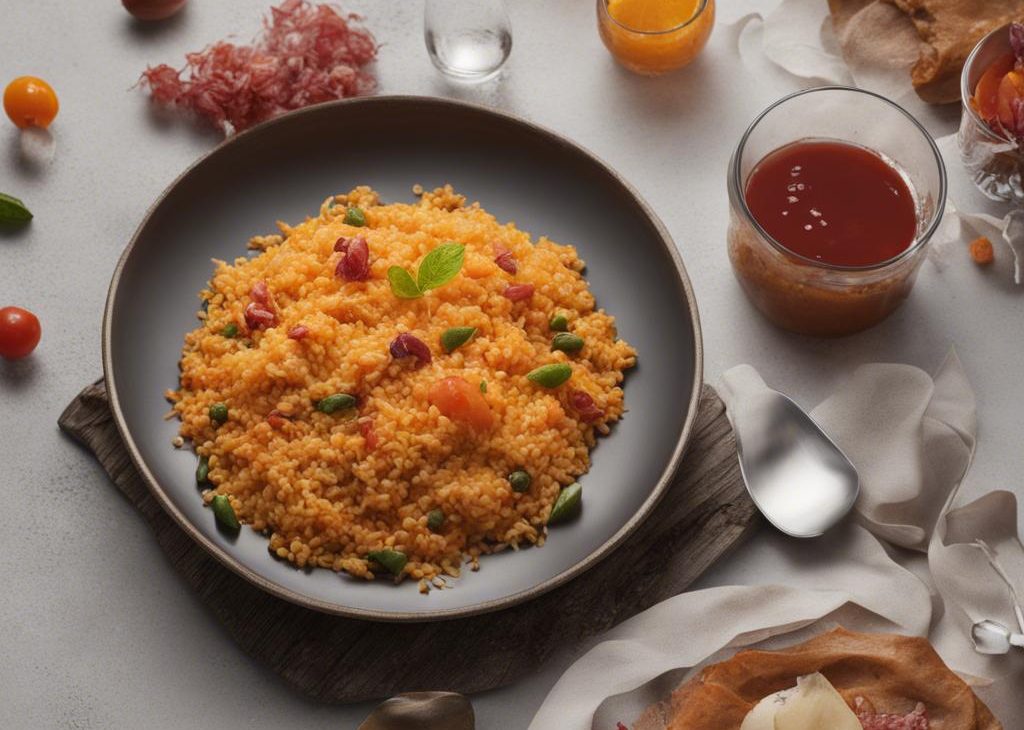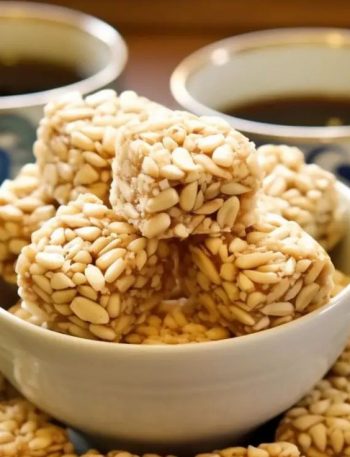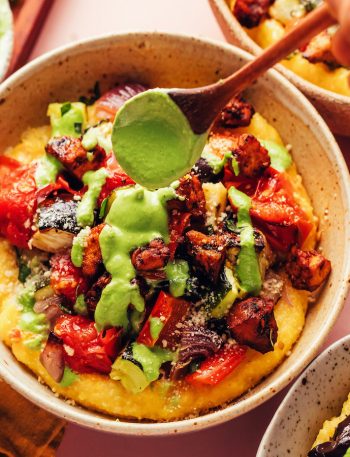
Gandasturi, a mouth-watering delicacy from the heart of Indonesia, is a gem that beautifully encapsulates the rich and diverse culinary tradition of this Southeast Asian country. This traditional snack, often enjoyed during festive celebrations or as a casual treat, features a dreamy combination of mung beans and creamed coconut encased in a crisp dough made from all-purpose and rice flour.
The unique addition of pandan leaves brings a sweet, floral fragrance that’s both comforting and tantalizing. Each bite of Gandasturi offers a delightful contrast of textures – the crispy outer layer giving way to a soft, sweet, and rich filling. Making Gandasturi at home is an experience in itself, a journey through the authentic flavors of Indonesia.
So, roll up your sleeves and get ready to dive into the art of making Gandasturi!
What is Gandasturi?
Gandasturi, also known as ‘Pandan Mochi’ or ‘Pandan Glutinous Rice Cake’, is a traditional Indonesian snack that originated from the island of Java. It is made by filling a dough shell with a mixture of sweetened mung beans and creamed coconut, and then steaming or frying it to perfection.
This delicious treat is popular not only in Indonesia but also in other Southeast Asian countries like Malaysia, Singapore, and Brunei. It is often served during special occasions such as weddings, birthdays, and religious festivals like Eid al-Fitr.
Why You’ll Love This Gandasturi?
There are countless reasons to love Gandasturi. The flavors, textures, and aroma of this snack are simply irresistible. But beyond that, making Gandasturi is a cultural experience in itself. As you prepare this delightful treat, you will be transported to the vibrant streets of Indonesia with its bustling food markets and rich culinary heritage.
Moreover, Gandasturi is made with simple and wholesome ingredients, making it a healthier alternative to many store-bought snacks. The combination of mung beans and coconut also provides a good source of protein and healthy fats.
The Ingredients
Step by Step Instructions
Step 1: Make the Dough
Step 2: Prepare the Filling
Step 3: Roll Out the Dough
Step 4: Add the Filling
Step 5: Fold and Seal
Step 6: Steam or Fry
Option A – Steaming:
Option B – Frying:
Step 7: Serve and Enjoy
Notes
- For a gluten-free option, use only rice flour or substitute with gluten-free all-purpose flour.
- If you can’t find pandan leaves, you can use pandan extract for the same aroma and flavor.
- To make a healthier version of Gandasturi, try baking it instead of steaming or frying. Simply brush some oil on top of the dough before baking at 375°F for about 20 minutes.
- To make the filling more creamy, you can add a little bit of coconut milk to the mixture while cooking.
- For extra sweetness, you can sprinkle some powdered sugar on top of the Gandasturi before serving.
Nutrition Information
How to store Gandasturi?
If you have any leftovers, store them in an airtight container in the refrigerator for up to 3 days. You can reheat them by steaming or microwaving for a few seconds before serving.
Gandasturi can also be frozen for longer storage. Simply place them in a single layer on a baking sheet and freeze until firm, then transfer them to a freezer-safe container. They can be stored for up to 3 months in the freezer. When ready to eat, thaw them in the refrigerator overnight and reheat as desired.
Variations
Gandasturi can be made with different fillings, such as grated coconut, palm sugar, or chocolate. You can also add some crispy fried shallots on top for an extra crunch.
1. Chocolate filling: Replace the mung bean filling with chopped chocolate or chocolate spread for a sweet and indulgent twist on traditional Gandasturi.
2. Palm sugar filling: Cook palm sugar with some water until it thickens, then add it to the mashed mung beans for a gooey and rich filling.
3. Coconut filling: Mix grated coconut with a small amount of sugar and salt, then use it as the filling for a more traditional version of Gandasturi.
4. Serving suggestion: To make it a complete meal, pair Gandasturi with some savory Indonesian dishes like Nasi Goreng (Indonesian fried rice) or Sate Ayam (grilled chicken skewers).
This snack is best enjoyed with a cup of hot tea or coffee. It can also be served as a dessert by drizzling some coconut milk or condensed milk on top.
Wrapping Up
Gandasturi is a delicious and versatile snack that can be enjoyed differently. With a few simple ingredients and some basic cooking skills, you can make this traditional Indonesian snack at home and impress your family and friends with its unique flavors. Plus, it’s a great way to use up leftover rice flour and mung beans.
So go ahead and give it a try, and remember to share your experience with us! Happy snacking!

Gandasturi Recipe
Description
Gandasturi, a mouth-watering delicacy from the heart of Indonesia, is a gem that beautifully encapsulates the rich and diverse culinary tradition of this Southeast Asian country.
Ingredients You’ll Need
Instructions
- Mix all-purpose flour, rice flour, salt, and oil in a bowl. Gradually add water and knead until a smooth dough forms. Cover with a damp cloth and let it rest for 30 minutes.
- Cook mung beans until soft, mash them. Combine creamed coconut, raw cane sugar, vanilla powder, and salt in a pan. Add mashed mung beans and cook until thickened.
- Roll out the rested dough into thin sheets. Cut small circles using a round object.
- Place mung bean mixture in the center of each dough circle.
- Fold edges over the filling, creating a half-moon shape. Seal edges with a fork.
- Option A – Steaming: Steam for about 20 minutes until fully cooked.
- Option B – Frying: Fry for 2-3 minutes per side until golden brown.
- Garnish with shredded coconut or sesame seeds. Serve hot or at room temperature.
Frequently Asked Questions
Yes, you can experiment with different types of beans such as red beans or black beans for a different flavor and texture. Just make sure to cook them until soft before mashing.
Pandan leaves provide a unique flavor to Gandasturi, but if they're not available, you could use vanilla extract or almond extract as an alternative. However, the taste will not be the same.
Yes, Gandasturi can be made vegan by ensuring that the sugar used is vegan-friendly and replacing the creamed coconut with a dairy-free alternative.







